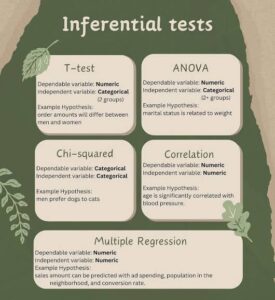Back to: ZOOLOGY 500 Level
Welcome to class!
Hello, my determined scholar! It’s wonderful to see your eagerness to master the tools that will help you unlock the stories behind data in zoology and ecology. Today, we’re focusing on Descriptive Statistics, t-tests, and ANOVA—three fundamental statistical methods that will enable you to analyse and interpret ecological data confidently, helping you draw meaningful conclusions about animal populations and environmental studies in Nigeria and beyond.
Descriptive Statistics, T-tests, Anova
Descriptive Statistics: Understanding Your Data
Before you start any complex analysis, you need to get to know your data. Descriptive statistics help you summarise and describe the main features of a dataset. These include:

Measures of central tendency like mean (average), median (middle value), and mode (most frequent value)
Measures of variability like range (difference between highest and lowest), variance, and standard deviation (how spread out data points are)
For example, if you measure the wingspan of 30 African Grey Parrots from different regions, descriptive statistics will help you understand the average wingspan and how much variation exists between individuals.
t-tests: Comparing Two Groups
The t-test helps you determine if there is a significant difference between the means of two groups. Imagine you want to compare the average weight of tilapia fish from two different rivers in Nigeria—River Niger and River Benue. A t-test can tell you whether the observed difference in weights is likely due to chance or if it’s statistically significant.
There are two common types:
Independent t-test: Used when comparing two different groups (e.g., two rivers)
Paired t-test: Used when comparing two related measurements (e.g., the same fish’s weight before and after a feeding trial)
ANOVA (Analysis of Variance): Comparing More Than Two Groups
Sometimes, you need to compare more than two groups. This is where ANOVA shines. Suppose you’re studying the effect of different soil types on the growth of a particular plant species in three different Nigerian states—Lagos, Kaduna, and Enugu. ANOVA helps you determine if the growth rates differ significantly across these groups.
If the ANOVA test shows a significant difference, you might need further tests to find out exactly which groups differ from each other.
Why Are These Important in Ecology and Zoology?
In ecological research, these tests help you:
Validate your observations with numbers
Identify patterns and differences in animal behaviour, growth, or environmental factors
Make informed decisions about conservation or management strategies

For example, if you’re testing a new method to improve fish farming, you need statistics to prove if your method actually works better than traditional ones.
Real-Life Nigerian Example
A researcher in Ibadan might use ANOVA to compare the impact of different pesticide levels on three species of crop pests, helping farmers choose the safest and most effective pest control method.
Summary
- Descriptive statistics summarise and describe data features like averages and spread.
- t-tests compare the means of two groups to see if differences are statistically significant.
- ANOVA compares means across three or more groups to detect significant differences.
- These tools help ecologists and zoologists make sense of their data and back up their findings scientifically.
Evaluation
- What is the purpose of descriptive statistics?
- When would you use a t-test instead of ANOVA?
- Give an example of a question that could be answered using ANOVA.
- Why is statistical analysis important in ecological research?
You are mastering the language of data—an essential skill that transforms raw numbers into powerful knowledge. With every lesson, you’re growing into a confident scientist ready to impact Nigeria’s environment and beyond. Keep pushing forward; Afrilearn is proud to be part of your success journey!
